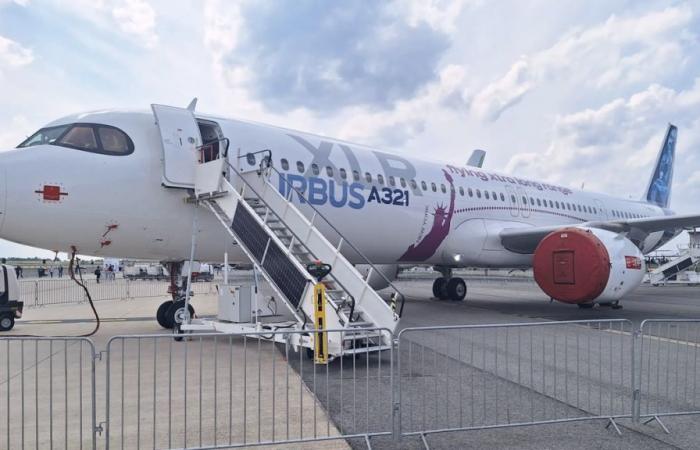Performing continental flights in smaller aircraft: it is now possible with the new Airbus A321-XLR. Adapted for Swiss and airports such as Basel, this device remains ruled out, for the moment, by the parent company Lufthansa.
Stefan Brändle, Paris / ch media
Airbus announced on Wednesday, from its headquarters in Toulouse, the delivery of the first A321-XLR to Iberia. The Spanish company has confirmed that this aircraft will make its inaugural flight next Wednesday, between Madrid and Paris. Subsequently, it will be mainly assigned to transatlantic routes, notably to Boston.
This is a first for a single-aisle aircraft, even if the American manufacturer Boeing had already launched a similar model, the B757, which it stopped producing in 2004 due to its insufficient range and its limited comfort.
The A321-XLR has a range extended to 8,700 kilometers, 1,300 more than previous versions. From Europe, it will allow non-stop connections to destinations in the United States, Latin America, the Middle East and India, with a medium-range aircraft that can accommodate up to 220 passengers.
Boeing can’t compete
Connections such as Rome-New York, London-Vancouver or Berlin-India become possible with a smaller, lighter and therefore less expensive aircraft. According to Airbus, the cost per seat falls by 30%. Until now, only large twin-aisle aircraft, such as the Boeing 747 and 787 or the Airbus A380 and A350, covered these distances, operating mainly from the hubs of large airlines such as Emirates or Lufthansa, which rely on these large carriers for their correspondence centers.
In contrast, the A321-XLR can serve medium-sized cities or destinations with lower passenger traffic non-stop. Even before its first commercial flight, Airbus had already recorded more than 500 orders for this aircraft, on which it enjoys a monopoly: competitor Boeing has still not finalized its own mid-range model, the “NMA” ( New Midsize Aircraft), due to several ongoing difficulties.
Airbus engineers have carried out numerous improvements. Since 2019, as part of the XLR project, they have completely reorganized the luggage compartments, freeing up space in the lower fuselage to install additional fuel tanks, which made it possible to achieve a range of 8,700 kilometers.
Airbus could even have pushed the autonomy to 9,000 kilometers for this “Extra Long Range” version, but the European Aviation Safety Agency (EASA) imposed some technical concessions.
Low-cost airlines from countries like India are already showing strong interest in this aircraft. Among the traditional European carriers, Iberia is not the only one interested: the Irish Aer Lingus, for example, plans to replace its old A330s with at least half a dozen A321-XLRs.
Swiss waiting
Some companies are exercising caution. Questioned, Swiss indicates that a purchase of A321-XLR is “not planned”, although this option is “regularly re-evaluated”. The last word, however, belongs to its parent company, the Lufthansa group, which confirmed that it was “constantly reassessing” its potential purchases, while specifying that the A321-XLR was “not a priority at the moment”.
In June, the group’s CEO, Carsten Spohr, declared internally that very few routes would be suitable for this new Airbus, the Lufthansa group, with its associated brands such as Swiss, Austrian Airlines and Eurowings, continuing to favor its main hubs of Frankfurt and Munich.
For companies like AUA or Swiss, which serve smaller markets and would potentially be better suited to the A321-XLR, the hub model remains essential. However, airports like Basel EuroAirport are showing interest in direct connections, particularly to New York, a profitability only possible with a relatively small aircraft such as the A321-XLR.
Experts point out the risks of Lufthansa’s attachment to its hubswhile low-cost competitors, such as Indigo (India) or AirAsia, will probably continue to establish themselves in the intercontinental market with the A321-XLR – or even, why not, Wizz Air from Basel, a territory well known to this Hungarian company.
A real game changer
The decision could depend on passenger preferences. With 8,700 kilometers of autonomy, the A321-XLR allows flights of up to eleven hours. Making such a journey in a single-aisle with narrow seats, designed for 220 passengers, may not appeal to everyone, however. Iberia thus equipped its first unit with reclining seats in business class, reducing the number of seats to 182 but consequently increasing the cost of the ticket.
Paul Chiambaretto, aeronautics specialist in Toulouse, believes that the A321-XLR represents, in any case, a real “gamechanger” which will “revolutionize” civil air transport. The success of this plane is assured and could disrupt many flight plansby calling into question the principle of hubs and connections in large airports.
Environmentally speaking, we should not expect miracles from the A321-XLR. If the elimination of stopovers and the reduction in weight reduce the ecological footprint per passenger, overall, this new device risks making air transport even more attractive.
Translated and adapted from German by Léon Dietrich






